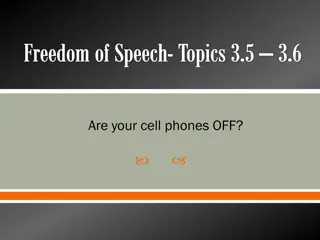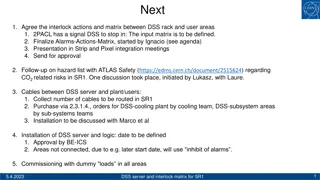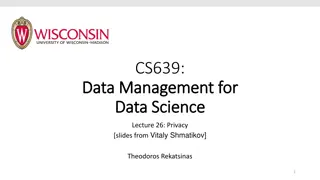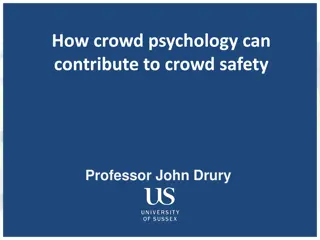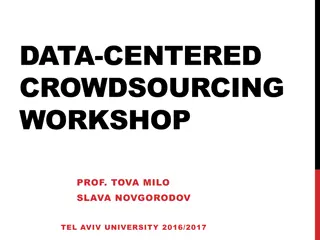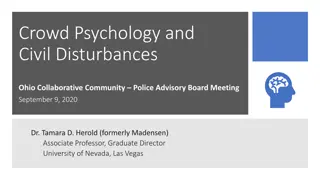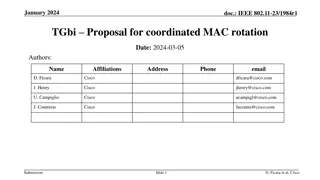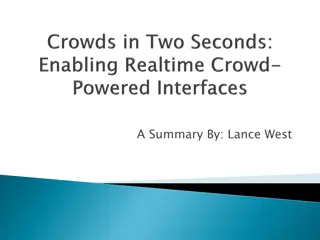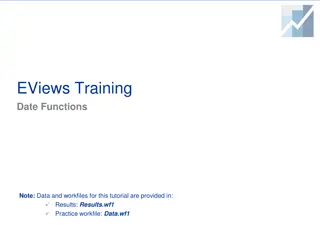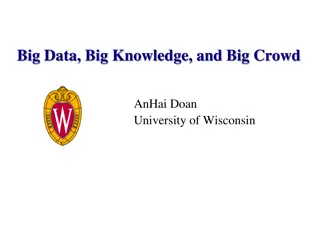Enhancing Crowd Anonymity with Dummy Jondos
Explore the concept of using dummy jondos to increase anonymity in crowds and mitigate common attacks like eavesdropping and collusion. Learn how the introduction of dummy jondos can impact crowd size and resistance against potential threats, along with considerations for implementation and ensuring organizer integrity.
Download Presentation

Please find below an Image/Link to download the presentation.
The content on the website is provided AS IS for your information and personal use only. It may not be sold, licensed, or shared on other websites without obtaining consent from the author.If you encounter any issues during the download, it is possible that the publisher has removed the file from their server.
You are allowed to download the files provided on this website for personal or commercial use, subject to the condition that they are used lawfully. All files are the property of their respective owners.
The content on the website is provided AS IS for your information and personal use only. It may not be sold, licensed, or shared on other websites without obtaining consent from the author.
E N D
Presentation Transcript
Increasing Anonymity in Crowds via Dummy Jondos By: Benjamin Winninger
Introduction and Problem Faced When it comes to crowds, bigger is always better, as most anonymity metrics are directly dependent on crowd size. I was attempting to include dummy jondos to bolster crowd size and increase resistance against three common attacks: Local eavesdropper End server Collaborating jondo
How To Determine If Dummy Jondos Improve Crowds In order to determine if dummy jondos are even worth utilizing, we need to compare: The likelihood of a degree of anonymity being provided against a class of attacker in the traditional and new crowd schemes.
Crowds: Technical Overview Collection of users, each represented by their jondo processes. Jondos contact blender server to request admission to the crowd. Once in the crowd, a user sends a request: The jondo forwards the request to another jondo with probability pf(virtual circuit created) Or to the end server with probability 1-pf
Dummy Jondos: Original Concept The crowd organizer can add an arbitrary amount of jondos to the crowd, thereby increasing the size of the crowd n to a large value. Chance of a local eavesdropper getting lucky drops significantly. This makes the amount of collaborators c required to perform a collaborating jondo attack (possibly unachievably) large.
Dummy Jondos: Original Concept Problems Sounds like we ve beaten the system, but If the organizer is corrupt, he is now in the perfect position to perform the collaborating jondo attack! How can the organizer properly set up and control proxies that he might not own?
Dummy Jondos: New Concept Rather than introducing outside users to the crowd, make better use of the registered users. We can no longer add an arbitrary number of jondos, but try to bring in registered (inactive) jondos. Daemon process activated on computer startup: bring user s jondo into the crowd in dummy mode.
Dummy Jondos: New Concept Consider that it is entirely possible that a user may never request to use the Web. Paths generated for the crowd will never include this jondo. User may be using a text editor, fiddling with a virtual machine, developing a program, etc. We would have submaximal n without them!
Dummy Jondos: Dummy Mode vs. User Mode A jondo in user mode will act the same as the jondos in a traditional crowd. The jondo establishes a path, sends out requests, receives responses, forwards requests for others, and so on. After a period of inactivity within a percentage of a user defined timeout, switch to dummy mode.
Dummy Jondos: Dummy Mode vs. User Mode A dummy jondo should theoretically mimic what the user does: Store a list of previous requests from user mode and randomly repeat them? No : If a user made a payment, they would be scratching their head when they check their bank account or bitcoin wallet! Anonymity for a request subject to compromise when it is sent multiple times!
Dummy Jondos: Dummy Mode vs. User Mode Create a list of common servers (Google, Facebook, YouTube, etc.). Create a set of commands to execute on these servers (ping, whois, nslookup). Randomly execute one of the commands on one of the servers after a bounded random time interval (all editable values in a config file).
Dummy Jondos: Dummy Mode vs. User Mode If an attacker sees that a dummy jondo sent a request to Google for example, it wouldn t be particularly informative since Google is the most popular website in America. Even if a request wasn t to a popular server, the commands aren t being given by a user (shouldn t compromise anonymity) so who cares if they are compromised?
Red Circles: Collaborating Jondos Red Squares: Corrupt Servers Purple Circles: Dummy Jondos Green Squares: Good Servers Green Circles: Good Jondos
Degrees of Anonymity for Crowds
Local Eavesdropper Attack Local Eavesdropper: An attacker who can view all communication to and from a user. If the eavesdropper gets lucky and listens to the sender who submits to the server, then the sender is exposed! Otherwise, the receiver is beyond suspicion. As the size of the crowd increases, the probability of a local eavesdropper getting lucky decreases.
Dummy Jondos and the Local Eavesdropper Attack The probability of a jondo submitting its request to the end server is 1/n The same logic applies to a crowd with dummy jondos, but the size is now (n+d), where d represents the number of dummy jondos. The resulting probabilities are therefore 1/n 1/(n+d). Guarantee to provide no less anonymity than original crowd.
End Server Attack End Server: The web server to which the jondo s request is sent. Since the server can see traffic to and from itself, receiver anonymity isn t possible! Also, since any jondo could have forwarded the request, it is impossible to determine the originator. As the size of the crowd increases, the probability of determining which jondo forwarded the request decreases.
Dummy Jondos and the End Server Attack Unsurprisingly, there is almost no difference between a traditional crowd and one that uses dummy jondos. The crowd naturally strongly resists the end server attack. The only difference might be a crowd with dummy jondos could increase a crowd of size 1 or 2 to a more reasonable size.
Collaborating Jondo Attack Collaborating Jondos: A group of crowd members that can view all communication to and from collaborating users and pool this information together to find the sender of a request. If the inequality n (pf*(c+1))/(pf-(1/2)) is satisfied, then the sender has probable innocence. As the size of the crowd increases, the number of collaborating jondos that it can resist also increases!
Dummy Jondos and the Collaborating Jondo Attack Two ways to try and manipulate n (pf*(c+1))/(pf-(1/2)): We can increase n, via dummy jondos We can try and minimize pf/(pf-(1/2))
Dummy Jondos: Increasing n As we ve seen in the local eavesdropper attack: dummy jondos increase the size of the crowd from n to (n+d). Can rewrite inequality as (n+d) (pf*(c+1))/(pf-(1/2)) Same guarantee as the local eavesdropper attack: the crowd with dummy jondos will provide no less anonymity.
Dummy Jondos (Aside): Increasing Path Length While manipulating pfisn t specifically the responsibility of dummy jondos, it is worth considering to combat the collaborating jondo attack. No true minimum for pf/(pf-(1/2)), instead look for where increase in pf no longer becomes worth it . Clearly a subjective measure.
Dummy Jondos (Aside): Increasing Path Length It appears that sweet spot for pf for maximizing anonymity is somewhere in the range of [0.75,0.85]. However, as n grows this pf may not be sustainable for latency s sake. Thus, it might be desirable to have a sliding scale type of function for the pf in which the value is initially somewhere in the range of [0.75,0.85], but then drops slightly over time to accommodate growing/shrinking crowd size.
Conclusions Dummy jondos no longer set up a crowd to be attacked, but attempt to get an optimal crowd size relative to the number of registered users. Dummy jondos offer the promise of improved anonymity over traditional crowds with the guarantee of being no worse.
Conclusions The behavior of a dummy jondo should be relatively human-like, and so a more realistic behavioral model could likely be developed. When I begin implementing this system (eventually), I will be able to get real data to prove or refute initial ideas from this research (e.g. latency vs. pf). I will also be able to redefine various aspects as (inevitable) conflicts arise.
Why Does This Even Matter? With the recent leaks about NSA data collection, possibly now more than ever people are concerned with their e-privacy. Crowds offer scalability and good performance for Internet users while defending against several classes of attackers. Thus any improvement on crowds could make them more viable for mass usage.
References Diaz, Claudia, and Bart Preneel. "Taxonomy of Mixes and Dummy Traffic.". University of Leuven. Web. <http://freehaven.net/anonbib/cache/taxonomy- dummy.pdf>. Newman, Richard E. "Anonymity Crowds." CIS 6930/4930 Cryptographic Anonymity. University of Florida. Web. 22 Nov. 2015. <http://www.cise.ufl.edu/~nemo/anonymity/lectures/lect04aCrowds.ppt>. Reiter, Michael K., and Aviel D. Rubin. "Crowds: Anonymity for Web Transactions." ACM Transactions on Information and System Security 1 1.1 (1998): 66-92. CIS 6930/4930 Cryptographic Anonymity. University of Florida. Web. 20 Nov. 2015. <http://www.cise.ufl.edu/~nemo/anonymity/papers/crowds:tissec.pdf>. Shields, Clay, and Brian Neil Levine. "A Protocol for Anonymous Communication Over the Internet. Georgetown University. Web. 28 Nov. 2015. <http://people.cs.georgetown.edu/~clay/research/pubs/hordes-ccsfinal.pdf>. Wright, Matthew K.; Adler, Micah; Levine, Brian Neil; and Sheilds, Clay, "The Predecessor Attack: An Analysis of a Threat to Anonymous Communications Systems" (2002). Computer Science Department Faculty Publication Series. Paper 164. <http://scholarworks.umass.edu/cs_faculty_pubs/164>.




